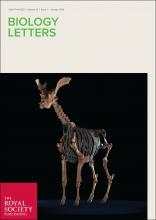Biology Letters facts for kids
 |
|
|
Abbreviated title (ISO 4)
|
Biol. Lett. |
|---|---|
| Discipline | Biology |
| Language | English |
| Edited by | David Beerling FRS |
| Publication details | |
| Publisher | |
|
Publication history
|
2005–present |
| Frequency | Monthly |
|
Open access
|
Hybrid |
|
Impact factor
(2022) |
3.3 |
| Indexing | |
| ISSN | 1744-957X |
| CODEN | BLLUAZ |
| Links | |
|
|
Biology Letters is a special science magazine published by the Royal Society. It's where scientists share their newest discoveries in biology. Imagine it as a place for quick updates on exciting research! The articles are checked by other experts before they are published. This makes sure the science is good and trustworthy.
The main editor is Professor David Beerling from the University of Sheffield. He works with many scientists from around the world. They all help decide which new research gets published.
Contents
What You'll Find in Biology Letters
This science magazine publishes short, important research articles. It also includes reviews and opinions from scientists. These articles cover all kinds of topics in biology.
Special Collections of Articles
Biology Letters sometimes publishes Special Features and Mini Series. These are collections of articles about one specific topic.
- Special Features can have up to 20 articles. They might appear in different issues of the magazine.
- Mini Series have up to six articles. They are all published together in one issue.
Some cool topics covered in these special collections include:
- How oceans are changing (called ocean acidification)
- Amazing fossil discoveries
- Why some animals are becoming extinct
- How plants can help with climate change
- How species spread out in different areas
Exciting Discoveries in the News
Many studies from Biology Letters get noticed by big news outlets. This means the research is often very interesting!
- One paper was about Goffin's cockatoos. These clever birds can make tools to get food! This story was in The Guardian and The New York Times.
- Another study talked about a "missing link" among dinosaurs. This big discovery was reported by BBC News and CNN.
- The most downloaded paper was from 2010. It was about bumblebee behavior. What's super cool is that pupils from Blackawton Primary School wrote this paper!
How Biology Letters Started
Biology Letters began in 2005. Before that, it was part of another science magazine called Proceedings of the Royal Society B: Biological Sciences. It started as a small extra section.
At first, it came out every three months. Then it changed to every two months. Since 2013, it has been published every month. The magazine now publishes all its short articles online. They stopped printing paper copies in 2020.
How Important is Biology Letters?
Biology Letters is listed in major science databases like Google Scholar and PubMed. This makes it easy for scientists to find the articles.
The magazine also has something called an "impact factor." This number helps show how important or influential a science magazine is. In 2022, Biology Letters had an impact factor of 3.3. This means it's a highly respected magazine. It ranked 32nd out of 92 journals in the "Biology" category.

